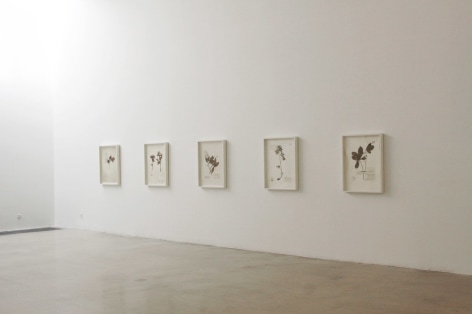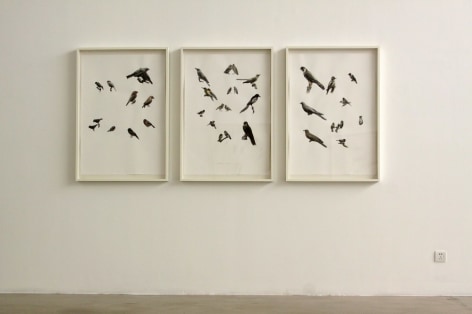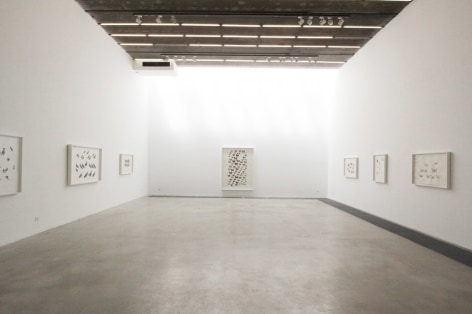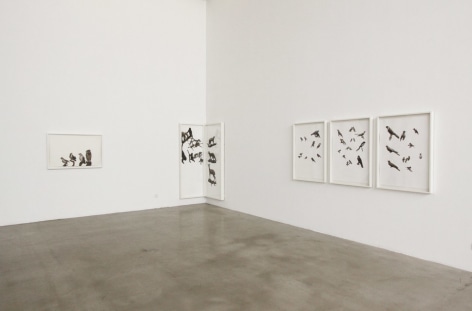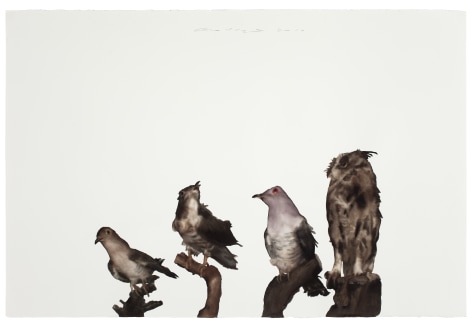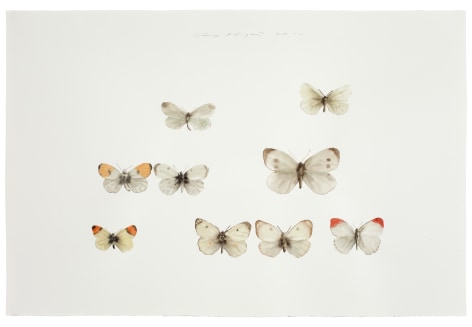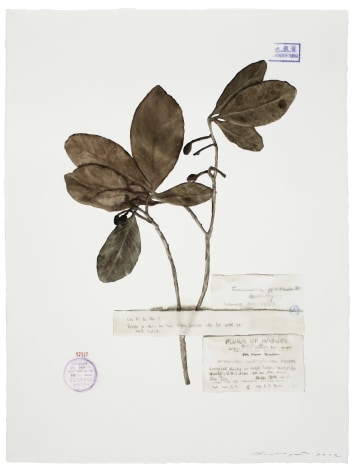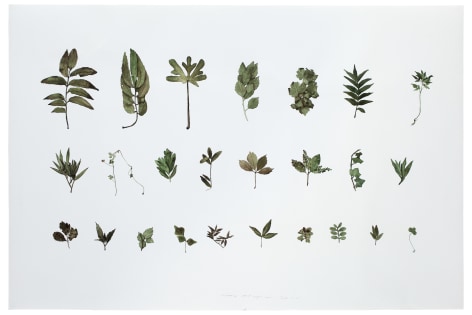Chambers Fine Art is pleased to announce the opening on May 5, 2012 of Guo Hongwei: Painting is Collecting. In this exhibition of watercolors on paper Guo Hongwei turns away from the everyday objects such as paper cups, plastic bags etc. that were the subject-matter of his works in various media in Things, his first solo exhibition at Chambers Fine Art in 2009, to encompass natural history as it has been collected and classified in a systematic way since at least the Renaissance. Since the beginning of his career, Guo Hongwei has used oil painting and watercolor not in pursuit of a Realist enterprise but as a means to investigate the relationship between the objects he chooses to represent and the infinite possibilities of his media in all their unpredictability.
In so far as he depicted objects close at hand in the paintings shown in the 2009 exhibition and immediately after, Guo Hongwei’s works were to a certain degree autobiographical. With Painting is Collecting , he moves out of the studio into a much broader arena that incorporates mankind’s curiosity concerning the world in which he lives, the classification and understanding of the relationships between the infinite variety of animals, insects, plants and minerals. Not only has he visited natural history museums and botanical gardens with their ancient herbaria, he has also read widely in historical literature and developed a keen appreciation of the artistry of botanical illustrators of previous centuries. From this vast amount of material, he has selected certain images that appeal to him as a result of their cultural patina and has also created arrangements of his own that show his interest in tracking relationships between closely related forms.
The series of watercolors devoted to plants, for example, are closely based on botanical specimens in which the date of collecting, inventory number etc. are only partially revealed as a result of the free-flowing pools of watercolor. Contrasting are the sheets in which rows of birds and insects are freely arranged, the minute differences between them beautifully replicated by the subtle adjustments of color and density of pigment. As Sun Dongdong comments, however, “thanks to Guo’s expressive painting style that breaks through the boundaries of scientific representation, the watercolors in the exhibition are not documentary studies meant for natural history museums. The naming of these paintings, “Flowers, Birds, Fish, and Insects,” is at best a playful allusion to scientific methods of categorization.”
Although capable of being highly developed, traditionally, watercolor has been reserved for informal studies and small-scale works. Guo Hongwei appreciates the fluidity and transparency of the medium but is prepared to place a greater burden on it, exaggerating its qualities in order to transform the physical characteristics of the objects he chooses to paint. For Painting is Collecting I, Guo Hongwei has transformed the galleries of Chambers Fine Art into a hauntingly beautiful reflection on mankind’s need to classify, preserve and depict, to pin down the qualities of living forms whether in watercolor on paper or in the vitrines of a natural history museum.
北京前波画廊非常荣幸地宣布郭鸿蔚个展《收集者》将于2012年5月5日开幕。在这个以纸上水彩为媒介的个展中,郭鸿蔚将着眼点从上一次个展《东西》中由多种绘画媒介呈现的纸杯、塑料瓶等日常事物滑向了自文艺复兴以来以收集和分类为方法而体系化的自然历史。从其早期的工作开始,他的绘画并不是去追寻现实主义,而是研究他选择的那些物体和媒介间的关系,并探索其无限可塑性。
《收集者》作为某种程度上自喃式的展览,看似是在以绘制的方式去收集主观的形式感片段,其实面对的却是一个更具普遍性,更根本的“似”的基础,一个人类主观的博物学基础。郭鸿蔚从充满触手可及日常之物的工作室里走向了一个更广阔的领域,其中充满了人对其所处世界的好奇,以及对无限种类的鸟兽虫石木所营造的自然界的分类定名和主观理解。他不仅造访了许多自然历史博物馆和植物园,还广泛的参考了标本绘本的历史文献,并加深了对几个世纪以来自然科学图谱艺术的理解。从庞杂的资料中,他选择了那些有着文化包浆和时间感的素材,并且以自己对于作为视觉表象的形式感的兴趣为尺度编排于纸面上。
作品中有一系列以植物馆中的标本为蓝本,画中将标本上的标签,收集日和序列号等信息悉数再造,但却只能以水彩其氤氲水渍的姿态被辨认出来。与之相映成趣的是,鸟或虫被以某种形式对比的需要排列于纸面上,微妙的形式差异浮现其间,被色彩和颜料浓度的调度精致地复制出来。如孙冬冬所述,“展览中的水彩作品根本不是博物学范式内的绘画,因为郭鸿蔚作品一贯的语言表征完全脱离了博物学对再现方法的学科要求,就像他对这些作品‘花鸟鱼虫’式的命名,如果从博物学角度来看,都像是一个假动作而已”。
虽然水彩已被作为一种技巧臻熟的绘画媒介,但是传统上,水彩作品仅被预设为小尺幅的习作。此次展览中,郭鸿蔚继续迷恋着其介质的通透和流动性,使用这种充满不确定性的媒介并放大其特质,使这种媒材变得分外有趣,同时物体作为物质本身所衍射的光晕也被散发出来。在《收集者》中,郭鸿蔚将画廊空间转化为一个戏说人类对分类、留存和描述的标本馆;不论是橱窗中展出的标本还是纸上的水彩作品,都呈现了生命最常态的本质。

